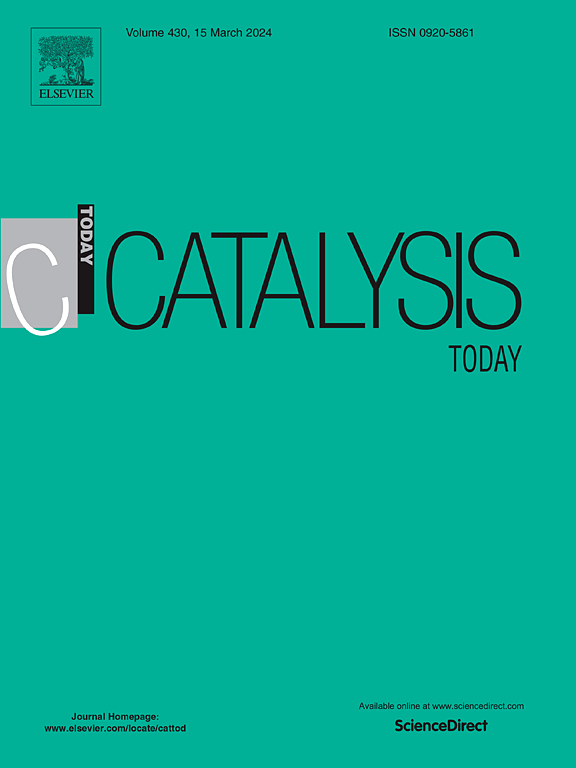3D打印镍铜改性煤飞灰CaNaX和NaX沸石可持续乙酰丙酸加氢
IF 5.2
2区 化学
Q1 CHEMISTRY, APPLIED
引用次数: 0
摘要
采用超声辅助双段熔融-水热合成的方法合成了不同Ca、Fe含量的Na(Ca)X结构粉煤灰沸石。采用合成后初始湿浸渍法制备了镍(5-10 wt%)和铜(2.5-5 wt%)含量不同的双金属Ni-Cu负载催化剂。采用3D打印技术制备金属前驱体改性后的催化剂。采用x射线粉末衍射(XRD)、导数热重程序还原(TPR-DTG)、N2物理吸附和透射电子显微镜(TEM)对催化剂进行了表征。结果表明,还原后的催化剂中形成了不同x/y比的NixCuy金属间纳米颗粒晶体,影响了活性镍相的还原性和催化性能。研究了木质纤维素生物质衍生乙酰丙酸(LA)制γ-戊内酯(GVL)的3D打印催化剂。研究发现,3D打印催化剂上富集镍的NiCu合金有利于催化剂的催化性能。所有3D打印样品都检测到沸石结构的保存,这对3D废催化剂中记录的金属分散有积极影响。3D打印的10Ni5Cu/NaCaX催化剂在200 °C反应温度下的LA转化率最高,GVL产率高,但在4个反应循环中表现出更稳定的催化性能。3D打印10Ni5Cu/NaX催化剂保留了沸石结构和金属分散,催化活性稳定,具有实际应用潜力。本文章由计算机程序翻译,如有差异,请以英文原文为准。
3D printed nickel-copper modified CaNaX and NaX zeolites obtained from coal fly ash for sustainable levulinic acid hydrogenation
Coal fly ash zeolites with Na(Ca)X structure with different Ca and Fe content were synthesized by ultrasound-assisted double stage fusion-hydrothermal synthesis. Bimetallic Ni-Cu supported catalysts with different nickel (5–10 wt%) and copper (2.5–5 wt%) content were prepared by post-synthesis incipient wetness impregnation. 3D printing technique was applied for the catalysts preparation after modification with metal precursors. The catalysts were characterized by X-ray powder diffraction (XRD), Temperature programmed reduction with derivative thermogravimetry (TPR-DTG), N2 physisorption and Transmission electron microscopy (TEM). It was found that crystalline NixCuy intermetallic nanoparticles with different x/y ratio were formed in the reduced catalysts and they affected the reducibility and catalytic performance of the active nickel phases. The 3D printed catalysts were studied in the lignocellulosic biomass-derived levulinic acid (LA) to γ-valerolactone (GVL). It was found that the presence of NiCu alloy rich of nickel on the 3D printed catalysts favors their catalytic performance in the studied reaction. The preservation of the zeolite structure was detected for all 3D printed samples, which has a positive influence on the metal dispersion registered in the 3D spent catalysts. The 3D printed 10Ni5Cu/NaCaX catalyst showed the highest LA conversion and high GVL yield at 200 °C reaction temperature but more stable catalytic performance was registered for the 10Ni5Cu/NaX catalyst in 4 reaction cycles. The preservation of zeolite structure and metal dispersion in 3D printed 10Ni5Cu/NaX catalyst resulted in stable catalytic activity in the studied reaction indicating its potential for practical application.
求助全文
通过发布文献求助,成功后即可免费获取论文全文。
去求助
来源期刊

Catalysis Today
化学-工程:化工
CiteScore
11.50
自引率
3.80%
发文量
573
审稿时长
2.9 months
期刊介绍:
Catalysis Today focuses on the rapid publication of original invited papers devoted to currently important topics in catalysis and related subjects. The journal only publishes special issues (Proposing a Catalysis Today Special Issue), each of which is supervised by Guest Editors who recruit individual papers and oversee the peer review process. Catalysis Today offers researchers in the field of catalysis in-depth overviews of topical issues.
Both fundamental and applied aspects of catalysis are covered. Subjects such as catalysis of immobilized organometallic and biocatalytic systems are welcome. Subjects related to catalysis such as experimental techniques, adsorption, process technology, synthesis, in situ characterization, computational, theoretical modeling, imaging and others are included if there is a clear relationship to catalysis.
 求助内容:
求助内容: 应助结果提醒方式:
应助结果提醒方式:


